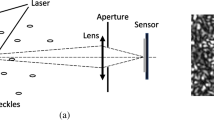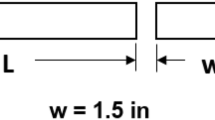Abstract
Ductile iron nodularity is of critical importance to its quality, but nodularity determination by metallographic analysis can be problematic. The widespread practice of estimating nodularity via comparator chart is highly subjective and prone to unacceptably high variation. An improvement over visual metallographic estimates is digital image analysis (IA) by which subjectivity can be greatly reduced, but the more reliable results obtained from IA are time-consuming and difficult to implement in a production environment. For this paper, the use of ultrasonic velocity testing via a standard coupon was evaluated as a possibly more reliable technique for determining front-end (real time) nodularity. Major results are presented herein along with details necessary for implementation of front-end ultrasonic nodularity determination using standard coupons as standard practice.




























Similar content being viewed by others
Change history
22 April 2019
In the original article, the authors neglected to explicitly state prior to presentation of results for the as-cast water-quenched (ACWQ) plus tempered coupons from the November, 2012 (Y2012) fade campaign that all reported velocities were measured prior to tempering, as the tempering was necessary only to facilitate the sectioning of those coupons by conventional band saw for their metallographic analysis. The tempering of such ACWQ coupons at 482 °C for 48 h raises their velocities by ~ 100 m/s.
References
J.W. Cree, Appendix B of Ductile Iron Society Report No. 42 (October, 2008 Version) Ultrasonic velocity testing of nodularity in coupons (2008)
AFS Committee 12-K, Microscopic test coupons. AFS Trans. Article No. 60–108, pp. 655–656
ASTM A247-17, ASTM Committee A04 and its subcommittee A04-21 on testing. Standard test method for evaluating the microstructure of graphite in iron castings
I. Riposan, M. Chisamera, S. Stan, Control of surface graphite degeneration in ductile iron for windmill applications. Int. J. Metalcast. 7, 9–20 (2013)
N. Ivan, I. Riposan, M. Chisamera, Mold coatings to reduce graphite degeneration in the surface layer of ductile iron castings. Int. J. Metalcast. 6, 61–70 (2012)
S. Boonmee, D.M. Stefanescu, Casting skin management in compacted graphite iron part II: mechanism of casting skin formation. AFS Trans. 13–1392, 449–459 (2013)
D.R. Askeland, F. Farinez, Factors affecting the formation of secondary graphite in quenched and tempered ductile iron. AFS Trans. 79–72, 99–106 (1979)
R.C. Voigt, C.R. Loper Jr., Secondary graphitization in quenched and tempered ductile cast iron. AFS Trans. 82–95, 239–255 (1982)
AFS Committee 5-J, Minimizing retained austenite in heat treated cast iron. Modern Casting, p. 50 (1995)
Results of AAM Casting-New Castle Research Presented at AFS Committee 5-R Meeting on 05/04/11
Results of AAM Casting-New Castle Research Presented at AFS Committee 5-R Meeting on 09/18/13
Results of AAM Casting-New Castle Research Presented at AFS Committee 5-R Meeting on 05/16/12
Results of AAM Casting-New Castle Research Presented at AFS Committee 5-R Meeting on 09/19/12
Results of AAM Casting-New Castle Research Presented at AFS Committee 5-R Meeting on 01/23/13
ASTM E2567-16a, ASTM committee E04 and its subcommittee E04-14 on quantitative metallography. Standard test method for determining nodularity and nodule count in ductile iron using image analysis
D.B. Coulston, LECO Corp., IA metallographic analyses conducted on ASTM A536-84(2014) Keel Block Test Bars from November, 2009 Fade Campaign for Correlation to Elastic Moduli (2009)
Results of AAM Casting-New Castle Research Presented to DIS Image Analysis Committee for Presentation at DIS Autumn, 2015 Meeting on 10/29/15
Results of AAM Casting-New Castle Research Presented at AFS Committee 5-R Meeting on 01/29/14
J.W. Cree, Gray iron aging effects as measured using NDT and microstructural analysis. Int. J. Metalcast. 11, 696–728 (2017). https://doi.org/10.1007/s40962-016-0105-8
K.E. Metzloff, C.R. Loper, Jr., Effect of nodularity, heat treatment and copper on the elastic modulus of ductile and compacted graphite irons. AFS Transactions, 01-088
A. Alagarsamy, Sound advice for nodularity testing. Mod. Cast. 95(7), 31–34 (2005)
H.E. Henderson, The effect of heat treatment on ultrasonic velocity of ductile iron castings. Iron Worker 40, 23–25 (1976)
A.G. Fuller, P.J. Emerson, G.F. Sergeant, A report on the effect upon mechanical properties of variation in graphite form in irons having varying amounts of ferrite and pearlite in the matrix structure and the use of nondestructive test in the assessments of mechanical properties of such irons. AFS Trans. 88, 21–50 (1980)
S.-C. Lee, J.-M. Suen, Ultrasonic nondestructive evaluation of matrix structures and nodularity in cast irons. Metall. Trans. A 20, 2399–2407 (1989)
H. Li, R.D. Griffin, C.E. Bates, Gray iron property measurements using ultrasonic techniques. AFS Trans. 113, 687–697 (2005)
Acknowledgements
The authors give special thanks to the following individuals for their invaluable assistance in getting front-end ultrasonic nodularity determination using standard coupons (FEUNDUSC) implemented as standard procedure for the real-time quantification of ductile iron nodularity at AAM Casting-New Castle: (1) To Marc Henry and Joe Marie of Team NDT, LLC, for their mentoring on the basic physics and fundamentals of ultrasonic testing. (2) To Clarke Steigerwald, Adam Babarik, Neethu Varghese, Nikhil Naik and Ricardo Jimenez of Midwest Information Systems, Inc., for their clear presentation of the capabilities of the PAX-it!® software for digital image analysis of cast irons and further tutoring on navigation of the software whenever it was needed. (3) To David Coulston of LECO Corporation for sharing his practical experience in using the PAX-it!® software for the digital image analysis of cast irons. (4) To Skip Weaver of Heraeus Electro-Nite Company for loaning thermal analysis equipment and donating ‘plain’ thermal analysis cups for the November 2009 fade campaign. (5) To Tom Kasee of Sawbrook Steel Castings for providing us with the plain hypoeutectoid carbon steel plates devoid of graphite nodules. Those plates of both ‘low’-carbon (more ferrite) and ‘high’-carbon (more pearlite) contents were used in evaluating the effect of ferrite/pearlite contents on ultrasonic velocity in the absence of graphite nodules. (6) To John Finley and Jim Miller of ASQ Section No. 0904 for their generous review and commentary on much of the statistical analysis presented in this paper. (7) To Nicholas Thornberry and Shana Beckley for their voluminous processing of highly detailed metallography reports that were necessary for drawing meaningful and statistically significant conclusions regarding correlations between metallography metrics and ultrasonic velocity. (8) To all AAM Casting-New Castle Melt Department personnel who provided support and assistance in the casting of all coupons used in the development work. (9) To Gary Bray, Herb McGhee, Craig Ead, Barry Mosier and others for their support and assistance with the FEUNDUSC development work in addition to their primary laboratory responsibilities for production support. (10) To Joe Sullivan and Jerry Krupp for doing comparative MAGMASOFT® solidification simulations of conventional metallographic micro-lugs and FEUNDUSC coupons. (11) To Tim Davis for his support in enabling compatible implementation of the FEUNDUSC testing procedure with AAM Casting-New Castle’s internal computer systems and his further assistance in facilitating data analysis.
Author information
Authors and Affiliations
Corresponding author
Additional information
Publisher's Note
Springer Nature remains neutral with regard to jurisdictional claims in published maps and institutional affiliations.
Electronic supplementary material
Below is the link to the electronic supplementary material.
40962_2019_322_MOESM1_ESM.pdf
Appendix 1. Effects of Varying Cu and Mn on ‘Fresh’ and ‘Aged’ Ultrasonic Velocities, presented at AFS Committee 5-R Meeting on 09/18/13 (PDF 98 kb)
40962_2019_322_MOESM6_ESM.pdf
Appendix 6. Effects of Carbon Content on the Ultrasonic Velocity and Microstructure of Hypoeutectoid Carbon Steels (PDF 901 kb)
Rights and permissions
About this article
Cite this article
Cree, J., Robles, M., Hoover, A. et al. Ductile Iron Front-End Ultrasonic Nodularity Determination Using Standard Coupons. Inter Metalcast 14, 861–893 (2020). https://doi.org/10.1007/s40962-019-00322-3
Published:
Issue Date:
DOI: https://doi.org/10.1007/s40962-019-00322-3




